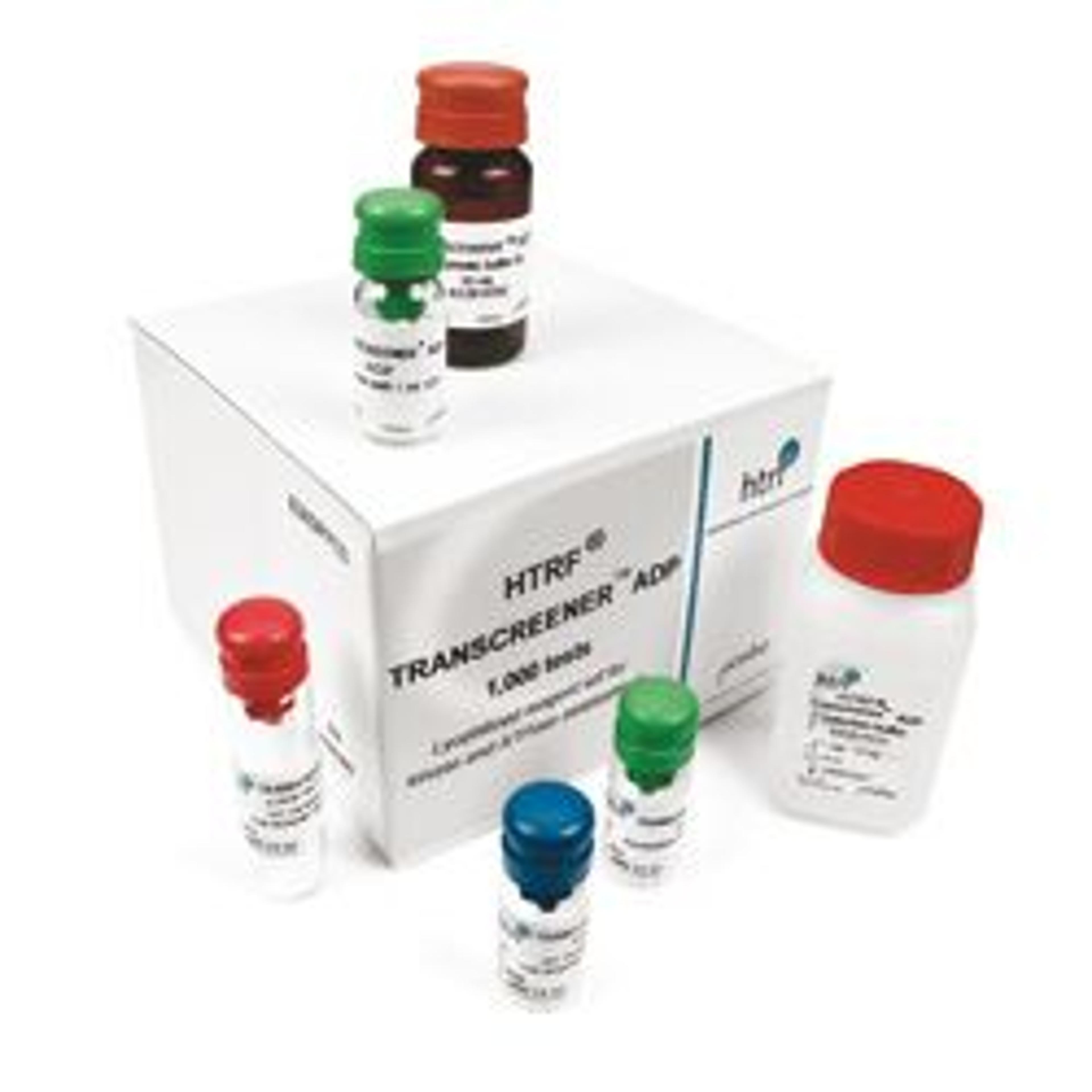Development of Eg5 using the HTRF Transcreener ADP kit
9 Oct 2008ADP is the universal product from kinase and ATPase activity. ADP measurement with HTRF technology avoids the limitations imposed by traditional methods of measuring the accumulation of ADP from kinases and ADP producing enzymes. Examples of these include the use of radioactivity (i.e. 33P) or the reliance upon a secondary enzyme (i.e. luciferase, peroxidase, pyruvate kinase) for detection. With radioactive methods, particular attention must be paid to safety and the proper disposal of materials, which can be costly. Further, assay sensitivity can be compromised as a result of high background levels. With enzyme coupled detection methods, the resulting data can be subject to high false-positive rates and sensitivity limitations can arise if high turnover by the target enzyme is required for the product’s detection by the secondary enzyme.
Compared to these different methods, HTRF Transcreener ADP assay is a homogeneous non-radioactive screening alternative. Enzyme-free detection enables a low false positive rate and for kinases, this kit represents a highly flexible solution as it is compatible with any substrate.
HTRF Transcreener ADP assay completes the existing HTRF solution portfolio for kinases and oncology, with the HTRF KinEASE platform, dedicated to Serine/Threonine and Tyrosine kinases, and the HTRF toolbox reagents, including a line of anti-phospho-residue antibodies.
HTRF Transcreener ADP assay is a competitive immunoassay performed in two steps, the enzymatic step followed by the detection step. Standard curves are drawn up to mimic ADP generation during an enzymatic reaction; total adenosine concentration (ATP+ADP) remains constant for each sample, while the percentage of ADP within each sample varies.
The 4-step-development of the Human Eg5 with HTRF Transcreener ADP assay will now be described.
Human Eg5, a member of the kinesin super family, plays a key role in mitosis, and is responsible for the formation and maintenance of the bipolar spindle. Eg5 has garnered substantial interest as a potential chemotherapeutic target in cancer treatment.
Eg5 was from Cytoskeleton, S-Trityl-L-cysteine (Eg5 inhibitor) was purchased from Calbiochem (Merck), ATP and MgCl2 are from SIGMA. All other reagents are kit components. Eg5, ATP and compounds were prepared in the enzymatic buffer provided with the kit, supplemented with 10 mM MgCl2. HTRF detection reagents were prepared in the detection buffer which contains 60 mM EDTA and 400 mM KF. For each step, an ATP/ADP titration curve was realized with the amount of ATP used in the assay.
Because EDTA contained in the detection buffer does not stop Eg5 activity, all experiments were performed in one step: 2 µL of Eg5 enzyme, 4 µL of ATP and 4 µL of enzymatic buffer were mixed with 5 µL of ADP-d2 and 5 µL of anti-ADP labelled with Eu3+ Cryptate.
The first step of the development consisted in the enzyme titration performed in order to obtain the optimal enzyme concentration. A two-fold dilution series of Eg5 was run, ranging from 250 nM to 7.8 nM final reaction concentrations (20 µL), and incubated at 100 µM final concentration of ATP (non limiting ATP concentration) (20 µL). HTRF detection reagents were added at the same time, and all the reagents were incubated at room temperature for 30 minutes. Eg5 optimal concentration was found at 60 nM.
For the enzyme kinetics, the second step, we used three different concentrations around the optimal, from 30 nM to 90 nM and 100 µM ATP. The plate was then read at different end points: 3’, 6’, 10’, 15’, 20’, 25’, 35’, 45 minutes, 1h, 2h, 3h, 4h, 5h and 22 hours.
The optimal incubation period for the 3 concentrations of Eg5 to achieve maximum signal and a linear time course was found to be 25 minutes (R2: 0.955 for Eg5 60 nM).
The third step is the ATP titration: a standard curve was generated for each ATP concentration used in the assay. Assays were run with a fixed concentration of enzyme (60 nM) and different concentrations of ATP from 5 µM to 200 µM final for 25 minutes. The amount of ADP produced was plotted against ATP concentrations using the Michaelis-Menten equation. The apparent Km was obtained at 75 µM.
For the inhibition experiment, Eg5 enzyme at 60 nM was first pre-incubated at 37°C for 1h30 in presence of various concentrations of S-Trityl-L-cysteine from 500 µM to 30 nM, with a three fold dilution series between each concentration. Then ATP (100 µM) and HTRF detection reagents were added and the plate incubated at room temperature for 30 minutes. The IC50 was calculated using the inhibition curve and found at 0.87 µM.
In Salvatore DeBonis’ paper1, S-Trityl-L-cysteine is defined as a reference inhibitor of Eg5 activity and IC50 they obtained was 1.0 µM. Using HTRF Transcreener ADP assay the IC50 value (0.87 µM) is in the same range as that published.
Here we have shown a guideline for an ATPase assay development with HTRF Transcreener ADP. Universal and non-radioactive alternative, this solution is well-suited to a broad range of targets such as lipid kinases, ATPases and HSP. The homogeneous format and enzyme-free detection enable high throughput applications.
Reference
1 In vitro screening for inhibitors of the human mitotic kinesin Eg5 with antimitotic and antitumor activities
Salvatore DeBonis, Dimitrios A. Skoufias, Luc Lebeau, Roman Lopez, Gautier Robin, Robert L. Margolis, Richard H. Wade, and Frank Kozielski
Image shows:
- Assay principle
HTRF Transcreener ADP assay principle: during the enzymatic step, the kinase catalyses the transfer of a phosphate group from ATP to a substrate. For ATPase, ATP is converted into ADP and inorganic phosphate. Then in the detection step, native ADP and d2 labeled ADP compete for the anti-ADP antibody labeled with Eu3+ Cryptate. The signal is inversely proportional to the Eu3+ concentration of ADP in the sample.
- S-Trityl-L-cysteine inhibition curve

